Human settlement in England
| Greenwich | |
|---|---|
 Royal Observatory, Greenwich Royal Observatory, Greenwich | |
 | |
| Population | 30,578 (Peninsula and Greenwich West wards 2011) |
| OS grid reference | TQ395775 |
| • Charing Cross | 5.5 mi (8.9 km) WNW |
| London borough | |
| Ceremonial county | Greater London |
| Region | |
| Country | England |
| Sovereign state | United Kingdom |
| Post town | LONDON |
| Postcode district | SE10 |
| Dialling code | 020 |
| Police | Metropolitan |
| Fire | London |
| Ambulance | London |
| UK Parliament | |
| London Assembly | |
| 51°29′N 0°00′E / 51.48°N 0.00°E / 51.48; 0.00 | |
Greenwich (/ˈɡrɛnɪtʃ/ GREN-itch, /-ɪdʒ/ -ij, /ˈɡrɪn-/ GRIN-) is an area in south-east London, England, within the ceremonial county of Greater London, 5.5 miles (8.9 km) east-south-east of Charing Cross.
Greenwich is notable for its maritime history and for giving its name to the Greenwich Meridian (0° longitude) and Greenwich Mean Time. The town became the site of a royal palace, the Palace of Placentia, from the 15th century and was the birthplace of many Tudors, including Henry VIII and Elizabeth I. The palace fell into disrepair during the English Civil War and was demolished, eventually being replaced by the Royal Naval Hospital for Sailors, designed by Sir Christopher Wren and his assistant Nicholas Hawksmoor. These buildings became the Royal Naval College in 1873, and they remained a military education establishment until 1998, when they passed into the hands of the Greenwich Foundation. The historic rooms within these buildings remain open to the public; other buildings are used by the University of Greenwich and Trinity Laban Conservatoire of Music and Dance.
The town became a popular resort in the 18th century, and many grand houses were built there, such as Vanbrugh Castle (1717) established on Maze Hill, next to the park. From the Georgian period estates of houses were constructed above the town centre. The maritime connections of Greenwich were celebrated in the 20th century, with the siting of the historic vessels Cutty Sark and Gipsy Moth IV next to the river front, and the National Maritime Museum in the former buildings of the Royal Hospital School in 1934.
Historically an ancient parish in the Blackheath Hundred of Kent, the town formed part of the growing conurbation of London in the 19th century. When the County of London, an administrative area designed to replace the Metropolitan Board of Works, was formed in 1889, the parish merged with those of Charlton-next-Woolwich, Deptford St Nicholas and Kidbrooke to create the Metropolitan Borough of Greenwich. When local government in London was again reformed in 1965, it merged with most of the Metropolitan Borough of Woolwich, creating what is now the Royal Borough of Greenwich, a local authority district of Greater London.
History
Toponymy
The place-name 'Greenwich' is first attested in an Anglo-Saxon charter of 918, where it appears as Gronewic. It is recorded as Grenewic in 964, and as Grenawic in the Anglo-Saxon Chronicle for 1013. It is Grenviz in the Domesday Book of 1086, and Grenewych in the Taxatio Ecclesiastica of 1291. The name means 'green wic', indicating that Greenwich was what is known as a -wich town or emporium, from the Latin 'vicus'.
The settlement later became known as East Greenwich to distinguish it from West Greenwich or Deptford Strond, the part of Deptford adjacent to the River Thames, but the use of East Greenwich to mean the whole of the town of Greenwich died out in the 19th century. However, Greenwich was divided into the registration subdistricts of Greenwich East and Greenwich West from the beginning of civil registration in 1837, the boundary running down what is now Greenwich Church Street and Croom's Hill, although more modern references to "East" and "West" Greenwich probably refer to the areas east and west of the Royal Naval College and National Maritime Museum corresponding with the West Greenwich council ward. An article in The Times of 13 October 1967 stated:
East Greenwich, gateway to the Blackwall Tunnel, remains solidly working class, the manpower for one eighth of London's heavy industry. West Greenwich is a hybrid: the spirit of Nelson, the Cutty Sark, the Maritime Museum, an industrial waterfront and a number of elegant houses, ripe for development.
Manor of East Greenwich
Royal charters granted to English colonists in North America, as well as in Company Bombay and St Helena, often used the name of the manor of East Greenwich for describing the tenure (from the Latin verb teneo, hold) as that of free socage. New England charters provided that the grantees should hold their lands "as of his Majesty's manor of East Greenwich". This was in relation to the principle of land tenure under English law, that the ruling monarch (king or queen) was paramount lord of all the soil in the terra regis, while all others held their lands, directly or indirectly, under the monarch. Land outside the physical boundaries of England, as in America, was treated as belonging constructively to one of the existing royal manors, and from Tudor times grants frequently used the name of the manor of East Greenwich, but some 17th-century grants named the castle of Windsor. Places in North America that have taken the name "East Greenwich" include a township in Gloucester County, New Jersey, a hamlet in Washington County, New York, and a town in Kent County, Rhode Island. Greenwich, Connecticut was also named after Greenwich.
Early settlement

Tumuli to the south-west of Flamsteed House, in Greenwich Park, are thought to be early Bronze Age barrows re-used by the Saxons in the 6th century as burial grounds. To the east between the Vanbrugh and Maze Hill Gates is the site of a Roman villa or temple. A small area of red paving tesserae protected by railings marks the spot. It was excavated in 1902, and 300 coins were found dating from the emperors Claudius and Honorius to the 5th century. This was excavated by the Channel 4 television programme Time Team in 1999, broadcast in 2000, and further investigations were made by the same group in 2003.
The Roman road from London to Dover, Watling Street, crossed the high ground to the south of Greenwich, through Blackheath. This followed the line of an earlier Celtic route from Canterbury to St Albans. As late as Henry V, Greenwich was only a fishing town, with a safe anchorage in the river.
Viking
During the reign of Ethelred the Unready, the Danish fleet anchored in the River Thames off Greenwich for over three years, and the army encamped on the hill above. From here they attacked Kent and, in the year 1012, took the city of Canterbury, making Archbishop Alphege their prisoner for seven months in their camp at Greenwich, at that time within the county of Kent. They stoned him to death for his refusal to allow his ransom (3,000 pieces of silver) to be paid; and kept his body, until the blossoming of a stick that had been immersed in his blood. For this miracle his body was released to his followers, he achieved sainthood for his martyrdom and, in the 12th century, the parish church was dedicated to him. The present church on the site west of the town centre is St Alfege's Church, designed by Nicholas Hawksmoor in 1714 and completed in 1718.
Norman
The Domesday Book of 1086 records the manor of Grenviz in the hundred of Grenviz as held by Bishop Odo of Bayeux; his lands were seized by the crown in 1082. The name of the hundred was changed to Blackheath when the site of the hundred court was moved there in the 12th century. There has been a royal palace or hunting lodge here since before 1300, when Edward I is known to have made offerings at the chapel of the Virgin Mary.
Plantagenet
Subsequent monarchs were regular visitors, with Henry IV making his will here, and Henry V granting the manor, for life, to Thomas Beaufort, Duke of Exeter, who died at Greenwich in 1426. The palace was created by Humphrey, Duke of Gloucester, Henry V's younger brother and regent to his son Henry VI in 1447; he enclosed the park and erected a tower (Greenwich Castle) on the hill now occupied by the Royal Observatory. The Thames-side palace was renamed the Palace of Placentia or Pleasaunce by Henry VI's consort Margaret of Anjou after Humphrey's death. The palace was completed and further enlarged by Edward IV, and in 1466 it was granted to his queen, Elizabeth. Edward IV had previously been given permission by the Pope to establish a Franciscan friary of Observant Friars in Greenwich, this was done in 1485, two years after his death; the first Observant House in England, it was located on land adjacent to the palace. After rejecting papal authority in 1534, the Franciscan Observants were suppressed; refounded as Franciscan Conventual, the friary was dissolved in 1538, then re-established in 1555 for Observants, before the friars were finally expelled in 1559 and the friary was demolished in 1662.
Ultimately it was because the palace and its grounds were a royal possession (with a useful hill) that it was chosen as the site for Charles II's Royal Observatory, from which stemmed Greenwich's subsequent global role as originator of the modern Prime Meridian.
Tudor
The palace was the principal residence of Henry VII whose sons Henry (later Henry VIII) and Edmund Tudor were born here, and baptised in St Alphege's. Henry favoured Greenwich over nearby Eltham Palace, the former principal royal palace in south London, which was not on the River Thames and so was less accessible. Henry extended Greenwich Palace and it became his principal London seat until Whitehall Palace was built in the 1530s. Henry VIII married Catherine of Aragon and Anne of Cleves at Greenwich, and both of his daughters, Mary (18 February 1516) and Elizabeth (7 September 1533), were born at Greenwich. His son Edward VI also died there at age 15.
The palace of Placentia, in turn, became Elizabeth's favourite summer residence. Both she and her sister Mary used the palace extensively, and Elizabeth's Council planned the Spanish Armada campaign there in 1588.
Stuart
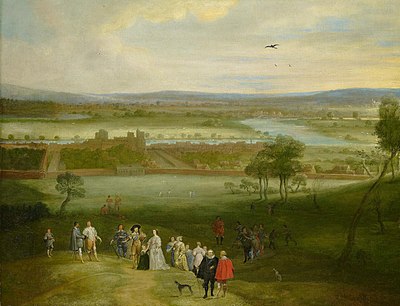
James I carried out the final remodelling work on Greenwich Palace, granting the manor to his wife Queen Anne of Denmark. In 1616 Anne commissioned Inigo Jones to design and build the surviving Queen's House as the final addition to the palace.
Charles I granted the manor to his wife Queen Henrietta Maria, for whom Inigo Jones completed the Queen's House. During the English Civil War, the palace was used as a biscuit factory and prisoner-of-war camp. Then, in the Interregnum, the palace and park were seized to become a 'mansion' for the Lord Protector.
By the time of the Restoration, the Palace of Placentia had fallen into disuse and was pulled down. New buildings began to be established as a grand palace for Charles II, but only the King Charles block was completed. Charles II also redesigned and replanted Greenwich Park and founded and built the Royal Observatory.
Prince James (later King James II & VII), as Duke of York and Lord High Admiral until 1673, was often at Greenwich with his brother Charles and, according to Samuel Pepys, he proposed the idea of creating a Royal Naval Hospital. This was eventually established at Greenwich by his daughter Mary II, who in 1692–1693 commissioned Christopher Wren to design the Royal Hospital for Seamen (now the Old Royal Naval College). The work was begun under her widower William III in 1696 and completed by Hawksmoor. Queen Anne and Prince George of Denmark continued to patronise the project.
Hanoverian
George I landed at Greenwich from Hanover on his accession in 1714. His successor George II granted the Royal Hospital for Seamen the forfeited estates of the Jacobite Earl of Derwentwater, which allowed the building to be completed by 1751.
In 1805, George III granted the Queen's House to the Royal Naval Asylum (an orphanage school), which amalgamated in 1821–1825 with the Greenwich Hospital School. Extended with the buildings that now house the National Maritime Museum, it was renamed the Royal Hospital School by Queen Victoria in 1892.
George IV donated nearly 40 paintings to the hospital in 1824, at a stroke creating a gallery in the Painted Hall. These now form the Greenwich Hospital Collection at the National Maritime Museum. Subsequently, William IV and Queen Adelaide were both regular donors and visitors to the gallery.
Victorian and Edwardian
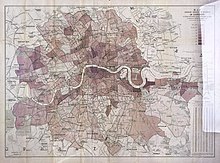
Queen Victoria rarely visited Greenwich, but in 1845 her husband Prince Albert personally bought Nelson's Trafalgar coat for the Naval Gallery.
In 1838 the London and Greenwich Railway (L&GR) completed the first steam railway in London. It started at London Bridge and had its terminus at London Street (now Greenwich High Road). It was also the first to be built specifically for passengers, and the first elevated railway, having 878 arches over its almost four mile stretch. South of the railway's viaduct over Deptford Creek is a Victorian pumping station constructed in 1864 as part of Joseph Bazalgette's London sewerage system (the Southern Outfall Sewer flows under Greenwich town centre).
In 1853 the local Scottish Presbyterian community built a church, St Mark's, nearby which was extended twice in the 1860s during the ministry of Adolph Saphir, eventually accommodating 1,000 worshippers.
In 1864 opposite the railway terminus, theatrical entrepreneur Sefton Parry built the thousand-seater New Greenwich Theatre. William Morton was one of its more successful managers. The theatre was demolished in 1937 to make way for a new Town Hall, now a listed building under new ownership and renamed Meridian House.
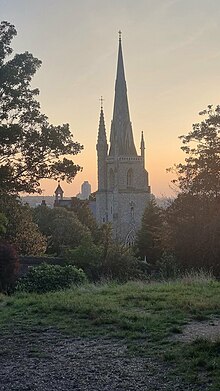
Greenwich Station is at the northern apex of the Ashburnham Triangle, a residential estate developed by the Ashburnham family, mainly between 1830 and 1870, on land previously developed as market gardens. It is now a designated conservation area. The present Greenwich Theatre, further to the east, on Croom's Hill, was constructed inside the shell of a Victorian music hall. Beginning life in 1855 as an annexe to the Rose and Crown, the music hall was rebuilt in 1871 by Charles Crowder and subsequently operated under many names. Further south on Croom's Hill, the Roman Catholic church of Our Ladye Star of the Sea was opened in 1851.
The meridian was established in 1851.
Modern and the present
George V and his wife Queen Mary both supported the creation of the National Maritime Museum, and Mary presented the museum with many items.
Prince Albert, Duke of York (later George VI), laid the foundation stone of the new Royal Hospital School when it moved out to Holbrook, Suffolk. In 1937 his first public act as king, three weeks before his coronation, was to open the National Maritime Museum in the buildings vacated by the school. The king was accompanied by his mother Queen Mary, his wife Queen Elizabeth (later Queen Elizabeth The Queen Mother) and Princess Elizabeth (later Queen Elizabeth II.)
Princess Elizabeth and her consort Prince Philip, who had been ennobled Duke of Edinburgh and Baron Greenwich on marriage in 1947, made their first public and official visit to Greenwich in 1948 to receive the Freedom of the Borough for Philip. In the same year, he became a trustee of the National Maritime Museum. Prince Philip was a trustee for 52 years until 2000, when he became its first patron. The Duke of Edinburgh was also a patron of the Cutty Sark (which was opened by the Queen in 1957) from 1952.
During the Silver Jubilee of 1977, the Queen embarked at Greenwich for the Jubilee River Pageant. In 1987, she was aboard the P&O ship Pacific Princess when it moored alongside the Old Royal Naval College for the company's 150th-anniversary celebrations.
To mark the Diamond Jubilee of Elizabeth II, on 3 February 2012 the Borough of Greenwich became the fourth London Borough to have Royal Borough status, the others being the Kingston upon Thames, the Kensington and Chelsea and the Windsor and Maidenhead. The status was granted in recognition of the borough's historic links with the monarchy, the location of the Prime Meridian and its being a UNESCO World Heritage Site.
Governance
Main article: Royal Borough of Greenwich
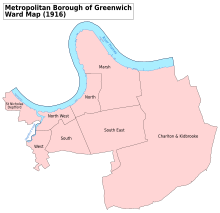
Greenwich is covered by the Greenwich West and Peninsula wards of the London Borough of Greenwich, which was formed in 1965 by merging the former Metropolitan Borough of Greenwich with that part of the Metropolitan Borough of Woolwich which lay south of the River Thames. Along with Blackheath Westcombe, Charlton, Glyndon, Woolwich Riverside, and Woolwich Common, it elects a Member of Parliament (MP) for Greenwich and Woolwich; Matthew Pennycook was elected as its MP in 2015 and later elections.
Geography
Geography of Greenwich
The town of Greenwich is built on a broad platform to the south of the outside of a broad meander in the River Thames, with a safe deep water anchorage lying in the river. To the south, the land rises steeply, 100 feet (30 m) through Greenwich Park to the town of Blackheath. The higher areas consist of a sedimentary layer of gravelly soils, known as the Blackheath Beds, that spread through much of the south-east over a chalk outcrop—with sands, loam and seams of clay at the lower levels by the river.
Greenwich is bordered by Deptford Creek and Deptford to the west; the residential area of Westcombe Park to the east; the River Thames to the north; and the A2 and Blackheath to the south. The Greenwich Peninsula, northeast of the town centre and also known as North Greenwich, forms the main projection of the town.
Nearby areas
- Blackheath
- Charlton
- Deptford
- Greenwich Peninsula
- Eltham
- Kidbrooke
- Lewisham
- New Cross
- Plumstead
- Shooters Hill
- Surrey Quays
- Thamesmead
- Westcombe Park
- Woolwich
- Welling
- Falconwood
- Abbey Wood
 The northwards view from Greenwich Park (in 2007), with the Queen's House and the wings of the National Maritime Museum in the foreground
The northwards view from Greenwich Park (in 2007), with the Queen's House and the wings of the National Maritime Museum in the foreground
Climate
This data was collected between 2005 and 2015 at the weather station in Greenwich:
Historically, the record high is 100 °F (38 °C) on 9 August 1911. This was the record for London until 2003, though it was disregarded due to non-standard instruments.
Greenwich has an oceanic climate (Köppen: Cfb) with warm summers and cool winters.
| Climate data for Greenwich Park, elevation: 47 m (154 ft), 1991–2020 normals, extremes 1948–2004 | |||||||||||||
|---|---|---|---|---|---|---|---|---|---|---|---|---|---|
| Month | Jan | Feb | Mar | Apr | May | Jun | Jul | Aug | Sep | Oct | Nov | Dec | Year |
| Record high °C (°F) | 16.8 (62.2) |
19.7 (67.5) |
23.3 (73.9) |
25.3 (77.5) |
29.0 (84.2) |
34.5 (94.1) |
35.3 (95.5) |
37.5 (99.5) |
30.2 (86.4) |
26.1 (79.0) |
18.9 (66.0) |
16.4 (61.5) |
37.5 (99.5) |
| Mean daily maximum °C (°F) | 8.5 (47.3) |
9.2 (48.6) |
12.1 (53.8) |
15.4 (59.7) |
18.6 (65.5) |
21.4 (70.5) |
23.8 (74.8) |
23.3 (73.9) |
20.3 (68.5) |
15.8 (60.4) |
11.6 (52.9) |
8.9 (48.0) |
15.8 (60.4) |
| Daily mean °C (°F) | 5.9 (42.6) |
6.2 (43.2) |
8.4 (47.1) |
10.7 (51.3) |
13.8 (56.8) |
16.7 (62.1) |
18.8 (65.8) |
18.7 (65.7) |
15.9 (60.6) |
12.4 (54.3) |
8.8 (47.8) |
6.3 (43.3) |
11.9 (53.4) |
| Mean daily minimum °C (°F) | 3.4 (38.1) |
3.2 (37.8) |
4.7 (40.5) |
6.0 (42.8) |
9.1 (48.4) |
12.0 (53.6) |
13.9 (57.0) |
14.1 (57.4) |
11.6 (52.9) |
9.0 (48.2) |
6.1 (43.0) |
3.8 (38.8) |
8.1 (46.6) |
| Record low °C (°F) | −12.7 (9.1) |
−9.4 (15.1) |
−6.7 (19.9) |
−4.8 (23.4) |
−1.0 (30.2) |
1.1 (34.0) |
5.0 (41.0) |
5.3 (41.5) |
1.1 (34.0) |
−2.1 (28.2) |
−8.0 (17.6) |
−10.5 (13.1) |
−12.7 (9.1) |
| Average precipitation mm (inches) | 43.9 (1.73) |
39.9 (1.57) |
36.5 (1.44) |
38.6 (1.52) |
44.0 (1.73) |
49.3 (1.94) |
36.3 (1.43) |
53.0 (2.09) |
52.4 (2.06) |
58.3 (2.30) |
59.9 (2.36) |
50.7 (2.00) |
562.9 (22.16) |
| Average precipitation days (≥ 1.0 mm) | 10.5 | 9.2 | 7.9 | 8.1 | 7.9 | 7.8 | 7.1 | 8.2 | 7.9 | 10.3 | 10.6 | 10.2 | 105.6 |
| Mean monthly sunshine hours | 44.4 | 66.1 | 109.7 | 152.9 | 198.7 | 198.6 | 209.2 | 198.0 | 140.6 | 99.7 | 58.5 | 50.1 | 1,526.4 |
| Source 1: Met Office | |||||||||||||
| Source 2: Starlings Roost Weather | |||||||||||||
Sites of interest
Riverfront
The Cutty Sark (a clipper ship) has been preserved in a dry dock by the river. A major fire in May 2007 destroyed a part of the ship, although much had already been removed for restoration. Nearby for many years was also displayed Gipsy Moth IV, the 54 feet (16.5 m) yacht sailed by Sir Francis Chichester in his single-handed, 226-day circumnavigation of the globe during 1966–67. In 2004, Gipsy Moth IV was removed from Greenwich, and after restoration work completed a second circumnavigation in May 2007. On the riverside in front of the north-west corner of the hospital is an obelisk erected in memory of Arctic explorer Joseph René Bellot.

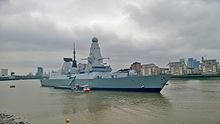
Near the Cutty Sark site, a circular building contains the entrance to the Greenwich foot tunnel, opened on 4 August 1902. This connects Greenwich to the Isle of Dogs on the northern side of the River Thames. The north exit of the tunnel is at Island Gardens, from where the famous view of Greenwich Hospital painted by Canaletto can be seen.
Rowing has been part of life on the river at Greenwich for hundreds of years and the first Greenwich Regatta was held in 1785. The annual Great River Race along the Thames Tideway finishes at the Cutty Sark. The nearby Trafalgar Rowing Centre in Crane Street is home to Curlew and Globe rowing clubs.
The Old Royal Naval College is Sir Christopher Wren's domed masterpiece at the centre of the heritage site. The site is administered by the Greenwich Foundation and several of the buildings are let to the University of Greenwich and one, the King Charles block, to Trinity College of Music. Within the complex is the former college dining room, the Painted Hall, this was painted by James Thornhill, and the Chapel of St Peter and St Paul, with an interior designed by James 'Athenian' Stuart. The Naval College had a training reactor, the JASON reactor, within the King William building that was operational between 1962 and 1996. The reactor was decommissioned and removed in 1999.
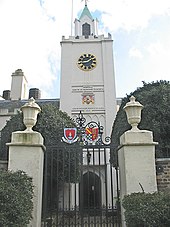
To the east of the Naval College is the Trinity Hospital almshouse, founded in 1613, the oldest surviving building in the town centre. This is next to the massive brick walls and the landing stage of Greenwich Power Station. Built between 1902 and 1910 as a coal-fired station to supply power to London's tram system, and later the London underground, it is now oil- and gas-powered and serves as a backup station for London Underground. East Greenwich also has a small park, East Greenwich Pleasaunce, which was formerly the burial ground of Greenwich Hospital.
The O2 (formerly the Millennium Dome) was built on part of the site of East Greenwich Gas Works, a disused British Gas site on the Greenwich Peninsula. It is next to North Greenwich Underground station, about 3 miles (4.8 km) north east from the Greenwich town centre, north west of Charlton. Pear Tree Wharf was associated with the gas works, being used to unload coal for the manufacturing of town gas, and is now home to the Greenwich Yacht Club. The Greenwich Millennium Village is a modern urban regeneration development to the south of the Dome. Enderby's Wharf is a site associated with submarine cable manufacture for over 150 years.
Greenwich Park
Main article: Greenwich ParkSouth of the former Naval College is the National Maritime Museum housed in buildings forming another symmetrical group and grand arcade incorporating the Queen's House, designed by Inigo Jones. Continuing to the south, Greenwich Park is a Royal Park of 183 acres (0.7 km), laid out in the 17th century and formed from the hunting grounds of the Royal Palace of Placentia.

The park rises towards Blackheath and at the top of this hill is a statue of James Wolfe, commander of the British expedition to capture Quebec. Nearby a major group of buildings within the park includes the former Royal Observatory, Greenwich; the Prime Meridian passes through this building.
Greenwich Mean Time was at one time based on the time observations made at the Royal Greenwich Observatory, before being superseded by the closely related Coordinated Universal Time (UTC). While there is no longer a working astronomical observatory at Greenwich, a ball still drops daily to mark the exact moment of 1 p.m., and there is a museum of astronomical and navigational tools, particularly John Harrison's marine chronometers.
The Ranger's House lies at the Blackheath end of the park and houses the Wernher Collection of art, and many fine houses, including Vanbrugh's house lie on Maze Hill, on the western edge of the park.
Town centre

Around the covered Greenwich Market, Georgian and Victorian architecture dominates in the town centre which spreads to the west of the park and Royal Naval College. Up the hill from the centre, there are many streets of Georgian houses, including the Fan Museum, on Croom's Hill. Nearby, at the junction of Croom's Hill with Nevada Street, is Greenwich Theatre; at the eastern end of Nevada Street is the Greenwich Tavern. To the west, the arthouse Greenwich Cinema is on Greenwich High Road, while the nearby Greenwich Playhouse closed in 2012.
Market

There has been a market at Greenwich since the 14th century, but the history of the present market dates from 1700 when a charter to run two markets, on Wednesdays and Saturdays, was assigned by Lord Romney (Henry, Earl of Romney) to the Commissioners of Greenwich Hospital for 1000 years.
The market is part of "the island site", bounded by College Approach, Greenwich Church Street, King William Walk and Nelson Road, near the National Maritime Museum and the Royal Observatory. The buildings surrounding the market are Grade 2 listed and were established in 1827–1833 under the direction of Joseph Kay. A market roof was added in 1902–1908 (and replaced in 2016). Later significant development occurred in 1958–1960 and during the 1980s.
The landowner, Greenwich Hospital, enhanced the market between 2014 and early 2016. Following the COVID-19 pandemic in 2020 the rents for several of the market stalls were increased by up to 60% as Greenwich Hospital's managing agent Knight Frank said it was losing money with fewer stalls operating and only four days of trading a week.
Millennium Leisure Park

About 1.0 mile (1.6 km) east of Greenwich town centre, the Millennium Leisure Park is an out-of-town retail park on Bugsby's Way in east Greenwich. It consists of retail outlets (IKEA and B&Q), restaurants and an Odeon cinema. The IKEA store here opened in 2019 as the retailer's fourth main store in London, following stores in Wembley (1988), Croydon (1992) and Tottenham (2005); the Greenwich store is the first in Inner London.
Greenwich Shopping Park is about 0.5 miles (0.8 km) further east, in Charlton.
Greenwich Mean Time
Main article: Greenwich Mean Time
Greenwich Mean Time (GMT) is a term originally referring to mean solar time at the Royal Observatory, Greenwich, which overlooks the River Thames from a hill in Greenwich Park. GMT is commonly used in practice to refer to Coordinated Universal Time (UTC) when this is viewed as a time zone, especially by bodies connected with the United Kingdom, such as the BBC World Service, the Royal Navy, the Met Office and others, although strictly UTC is an atomic time scale which only approximates GMT with a tolerance of 0.9 second. It is also used to refer to Universal Time (UT), which is a standard astronomical concept used in many technical fields and is often referred to by the military in the phrase Zulu time.
As the United Kingdom grew into an advanced maritime nation, British mariners kept at least one chronometer on GMT in order to calculate their longitude from the Greenwich meridian, which was by convention considered to have longitude zero degrees (this convention was internationally adopted in the International Meridian Conference of 1884). The synchronization of the chronometer on GMT did not affect shipboard time itself, which was still solar time. But this practice, combined with mariners from other nations drawing from Nevil Maskelyne's method of lunar distances based on observations at Greenwich, eventually led to GMT being used worldwide as a reference time independent of location. Most time zones were based upon this reference as a number of hours and half-hours "ahead of GMT" or "behind GMT".
In recognition of the suburb's astronomical links, Asteroid 2830 has been named 'Greenwich'.
World Heritage Site
| UNESCO World Heritage Site | |
|---|---|
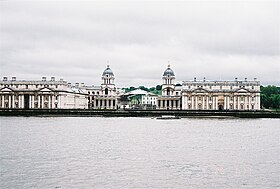 Old Royal Naval College and University of Greenwich buildings on the south bank of the River Thames Old Royal Naval College and University of Greenwich buildings on the south bank of the River Thames | |
| Location | United Kingdom |
| Criteria | Cultural: i, ii, iv, vi |
| Reference | 795 |
| Inscription | 1997 (21st Session) |
| Extensions | 2008 |
| Area | 109.5 hectares (271 acres) |
| Buffer zone | 174.85 hectares (432.1 acres) |
| Website | whc |
| Coordinates | 51°29′1″N 0°0′21″W / 51.48361°N 0.00583°W / 51.48361; -0.00583 |
In 1997 Maritime Greenwich was added to the list of World Heritage Sites, for the concentration and quality of buildings of historic and architectural interest. These can be divided into the group of buildings along the riverfront, Greenwich Park and the Georgian and Victorian town centre.
Discover Greenwich Visitor Centre

The Discover Greenwich Visitor Centre provides an introduction to the history and attractions in the Greenwich World Heritage Site. It is in The Pepys Building near to the Cutty Sark within the grounds of the Old Royal Naval College (formerly Greenwich Hospital); the building began life as an engineering laboratory for the college. The centre opened in March 2010, and admission is free.
The Centre explains the history of Greenwich as a royal residence and a maritime centre. Exhibits include:
- The history of the Palace of Placentia.
- Models of Christopher Wren's original designs for Greenwich Hospital.
- Six of the carved heads originally intended to decorate the exterior of the college's Painted Hall.
- Exhibition displays about Maritime Greenwich and its connections with the sea and exploration.
- "By Wisdom as much as War" – an exhibition about the history of the Royal Naval College during the years it occupied Greenwich Hospital (1873–1998).
Education
Main article: List of schools in GreenwichThe University of Greenwich main campus occupies most of the grand, landmark riverside vista buildings of the former Royal Naval College. The university has other campuses at Avery Hill in Eltham and at Medway. The Greenwich campus also houses the Trinity College of Music.
Ravensbourne University London is located on the Greenwich Peninsula and offers courses related to art and design. Its campus was designed by architect Farshid Moussavi.
Secondary schools in the area include The John Roan School, founded 1677, and St Ursula's Convent School, established 1850.
Transport
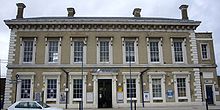
National Rail
Greenwich is served by Greenwich and Maze Hill stations with Southeastern services to London Cannon Street, Dartford, Barnehurst and Crayford as well as Thameslink services to Luton via London Blackfriars and to Rainham.
London Underground
The area is also served by North Greenwich station with Jubilee Line services to Stanmore and Stratford.
DLR
Greenwich is served by the Docklands Light Railway, with services from Greenwich and Cutty Sark stations to Bank via Canary Wharf and to Lewisham.
Buses
Greenwich is served by many London Buses routes.
- 129 to Lewisham Shopping Centre or North Greenwich
- 177 to Peckham via New Cross or to Thamesmead via Woolwich
- 188 to North Greenwich or to Russell Square via Canada Water, Elephant & Castle and Waterloo
- 199 to Bellingham via Lewisham & Catford or to Canada Water
- 286 to Sidcup via Blackheath and Eltham
- 386 to Blackheath or to Woolwich
- N1 to Tottenham Court Road station via Elephant & Castle and Waterloo or to Thamesmead via Woolwich (Night Bus)
- N199 to St Mary Cray via Lewisham, Catford, Bromley and Orpington and to Trafalgar Square via Canada Water and London Bridge (Night Bus)
Boat
There are a number of river boat services running from Greenwich Pier, managed by London River Services. The main services include the Thames commuter catamaran service run by Thames Clippers from Embankment, via Tower Millennium Pier, Canary Wharf and on to the O2 and Woolwich Arsenal Pier; the Westminster-Greenwich cruise service by Thames River Services; and the City Cruises tourist cruise via Westminster, Waterloo and Tower piers.
Pedestrian and cycle routes
The Thames Path National Trail runs along the riverside. The Greenwich foot tunnel provides pedestrian access to the southern end of the Isle of Dogs, across the river Thames.
The National Cycle Network Route 1 includes the foot tunnel, though cycling is not permitted in the tunnel itself.
Sports
Rowing
Greenwich is home to a variety of amateur sports clubs. Its location on the tidal Thames makes it a good location for rowing; the Trafalgar Rowing Centre in Crane Street is the clubhouse of the Curlew and Globe rowing clubs. The Globe has senior and junior squads, the latter renowned for its achievements at national and international level.
Running
The Thames Path and Greenwich Park are popular with runners. The 'red start' for the London Marathon is situated south of the park on Charlton Way (other starts are nearby in St John's Park, and on Shooter's Hill Road). After heading east through Charlton and Woolwich, the marathon route then turns west towards Greenwich; as runners reach the 10 km mark (6.2-mile), they pass the Old Royal Naval College and then loop around the prow of the Cutty Sark before continuing west towards Deptford.
Golf
The Greenwich Peninsula Golf Range at North Greenwich is a riverside golf driving range with 60 bays, a mini 18-hole adventure course, golf academy, golf shop and restaurant.
Twin towns
The twin towns of Greenwich are:
 Maribor, Lower Styria, Slovenia
Maribor, Lower Styria, Slovenia Reinickendorf, Berlin, Germany
Reinickendorf, Berlin, Germany Tema, Greater Accra, Ghana
Tema, Greater Accra, Ghana Hangzhou, China
Hangzhou, China
Literature
Edward Lear makes reference to Greenwich in More Nonsense Pictures, Rhymes, Botany, etc:
There was a young lady of Greenwich,
Whose garments were bordered with Spinach;
But a large spotty calf
Bit her shawl quite in half,
Which alarmed that young lady of Greenwich.
See also
- Greenwich Cablevision
- List of people from Greenwich
- List of World Heritage Sites of the United Kingdom
Notes
- Voting took place on 13 October and the resolutions were adopted on 22 October 1884.
References
- "Greenwich". Oxford English Dictionary (Online ed.). Oxford University Press. (Subscription or participating institution membership required.)
- Roach, Peter; Setter, Jane; Esling, John, eds. (2011). Cambridge English Pronouncing Dictionary (David Jones) (18th ed.). Cambridge: Cambridge University Press.
- Eilert Ekwall, The Concise Oxford Dictionary of English Place-names, p. 204.
- ^ "Parishes: Greenwich". british-history.ac.uk.
- "Greenwich-the instant village", Brandon Green, The Times, 13 October 1967; p. 11.
- Colonial Charters, Grants and Related Documents Archived 4 July 2011 at the Wayback Machine.
- Stern, Philip J. (2011). The Company-State: Corporate Sovereignty and the Early Modern Foundations of the British Empire in India. Oxford: Oxford University Press. pp. 23–24. ISBN 978-0195393736.
- Manor of East Greenwich Archived 5 September 2015 at the Wayback Machine.
- National Archives, Great Domesday Archived 29 September 2015 at the Wayback Machine.
- Words used in The First Charter of Virginia; 10 April 1606 Archived 1 November 2011 at the Wayback Machine "...To BE HOLDEN of Us, our heirs and Successors, as of our Manor at East-Greenwich, in the County of Kent, in free and common Soccage only, and not in Capite."
- Words used in Charter for the Province of Pennsylvania-1681 Archived 28 April 2011 at the Wayback Machine "...to bee holden of Us , Our heires and Successors, Kings of England, as of Our Castle of Windsor in Our County of Berks, in free and comon Socage, by fealty only for all Services, and not in Capite or by Knights Service."
- "N.N." On the Tenure of the Manor of East Greenwich Archived 20 November 2017 at the Wayback Machine.
- Edward P. Cheyney, The Manor of East Greenwich, American Historical Review, Volume 11, 1 October 1905.
- Flamsteed House – designed and built by Sir Christopher Wren in 1675–76, was the home of the first Astronomer Royal, John Flamsteed, and the heart of Charles II's new Royal Observatory.
- "Roman remains". Royal Parks. Archived from the original on 29 May 2023. Retrieved 24 July 2015.
{{cite journal}}: Cite journal requires|journal=(help) - "Greenwich London". Time Team. Channel 4. 2 February 2003. Retrieved 13 June 2011.
- The Roman Watling Street: from London to High Cross O. Roucoux, (Dunstable Museum Trust, 1984) ISBN 0-9508406-2-9.
- Open Domesday Online: Greenwich Archived 10 February 2017 at the Wayback Machine
- ^ 'Greenwich', The Environs of London: volume 4: Counties of Herts, Essex & Kent (1796), pp. 426–93 Archived 7 June 2007 at the Wayback Machine, accessed: 26 May 2007.
- ^ "Greenwich Greyfriars". Historic England Research Records. Heritage Gateway. Retrieved 19 March 2023.
- Carlyle, E. I. (1897). "Saphir, Adolph" . Dictionary of National Biography. Vol. 50. p. 299.
- The Era, 29 May 1864, p. 10, New Greenwich Theatre.
- Historic England. "The Borough Hall and Meridian House (former Greenwich Town Hall) (1213855)". National Heritage List for England. Retrieved 24 April 2020.
- Report on Ashburnham triangle by Conservation Team, Development Town Planning First Floor, Peggy Middleton House 50 Woolwich New Road, London SE18 6HQ.
- "Greenwich – Our Ladye Star of the Sea". Taking Stock: Catholic Churches of England and Wales. Retrieved 13 March 2023.
- See also Royal Borough.
- "Greenwich to become Royal Borough". Greenwich London Borough Council. 5 January 2010. Archived from the original on 8 January 2010. Retrieved 5 January 2010.
- "ukpollingreport.co.uk » Greenwich and Woolwich". ukpollingreport.co.uk. Archived from the original on 1 August 2013. Retrieved 24 September 2009.
- "1911 Weather Report". Met Office. 1 January 1912. Retrieved 24 July 2019.
- "Greenwich 1991–2020 averages". Met Office. Retrieved 20 November 2018.
- "Hot Spell - August 2003". Met Office. Retrieved 17 December 2018.
- "Record Breaking Heat and Sunshine - July 2006". Met Office. Retrieved 17 December 2018.
- "Monthly Extreme Maximum Temperature". Starlings Roost Weather. Retrieved 3 February 2023.
- "Monthly Extreme Minimum Temperature". Starlings Roost Weather. Retrieved 3 February 2023.
- The Foot Tunnel (Greenwich Guide) Archived 4 June 2014 at the Wayback Machine accessed 10 December 2007
- Just another source of neutrons? R.J.S. Lockwood and Prof. P.A. Beeley (Nuclear Dept., HMS Sultan, Gosport, 2001) Archived 30 October 2012 at the Wayback Machine accessed 29 December 2007
- Trinity Hospital (LB Greenwich) Archived 30 December 2009 at the UK Web Archive accessed 10 December 2007
- Greenwich Power Station (Powering the City) Archived 19 November 2022 at the Wayback Machine accessed 10 December 2007
- East Greenwich Gasworks (Powering the City) Archived 27 May 2013 at the Wayback Machine accessed 10 December 2007. The Greenwich Peninsula gas works, being themselves notable, as being the subject of an IRA bomb attack in the 1970s, in which one gasometer – and its contents – were spectacularly destroyed.
- Greenwich and Blackheath Past Felix Barker (Historical Publications Ltd., 1999) ISBN 0-948667-55-9
- General Wolfe Statue (Greenwich Guide) Archived 27 July 2013 at the Wayback Machine accessed 10 December 2007
- Howse 1997
- The Wernher Collection (Ranger's House) Archived 18 November 2007 at the Wayback Machine (English Heritage) accessed 10 December 2007
- History of Greenwich Market Archived 12 January 2012 at the Wayback Machine at Greenwich Hospital
- "Maritime Greenwich: World Heritage Site – Management plan" (PDF). Visit Greenwich. Royal Borough of Greenwich. Archived from the original (PDF) on 10 February 2017. Retrieved 26 September 2016.
- "Historic Regeneration Schemes". The Greenwich Phantom. Retrieved 26 September 2016.
- Butler, Sarah (19 August 2020). "London's Greenwich Market stalls fear closure following huge rent increase". The Guardian. ISSN 0261-3077. Retrieved 19 August 2020.
- Noble, Will (7 January 2019). "Ikea Greenwich is About to Open: Here's What You Need to Know". Londonist.
- Best, Chloe (6 February 2019). "IKEA Greenwich: All you need to know about the first inner-London superstore". Hello!.
- "What is GMT?". BBC World Service. 7 December 2007. Archived from the original on 18 March 2009. Retrieved 18 September 2009.
- Howse 1997, pp. 12, 137
- Dictionary of Minor Planet Names Lutz D. Schmadel (Springer 2003) ISBN 3-540-00238-3
- "Discover Greenwich Visitor Centre". Old Royal Naval College. Retrieved 25 March 2015.
- "Greenwich Council – Local travel services – Thames Clippers". www.greenwich.gov.uk. Archived from the original on 13 August 2009. Retrieved 24 September 2009.
- "Greenwich Council – Local travel services – River boat cruises". www.greenwich.gov.uk. Archived from the original on 14 April 2009. Retrieved 24 September 2009.
- "The Thames Path – Greenwich to the London Eye". www.thames-path.org.uk. Retrieved 24 September 2009.
- "National Cycle Network in London". Sustrans. Archived from the original on 11 March 2010. Retrieved 24 September 2009.
- "Trafalgar Rowing Centre". Curlew Rowing Club. Retrieved 21 March 2018.
- "Globe Rowing Club". www.globerowingclub.co.uk. Retrieved 20 March 2018.
- "Team announced for 2017 J16 GB v France Match - British Rowing". British Rowing. 10 July 2017. Retrieved 20 March 2018.
- ^ "Interactive Marathon Map". BBC News. 23 April 2009. Retrieved 13 May 2009.
- Norum, Ben (29 April 2015). "Greenwich Peninsula Driving Range: state-of-the-art riverside golf". Evening Standard. Retrieved 22 December 2022.
- "Sister cities of Greenwich (London borough)". Sister Cities of the World.
- Borsuk, By Ken. "Greenwich to welcome a new sister city: Hangzhou, China". Greenwich Time.
- Lear, Edward (1872). More Nonsense. Pictures, Rhymes, Botany, Etc. London: Robert J. Bush.
- Howse, Derek (1997). Greenwich Time and the Longitude. Phillip Wilson. ISBN 0-85667-468-0.
External links
- Greenwich World Heritage Site
- All Things Greenwich – a guide to local shops, services, restaurants, bars & pubs in Greenwich, South East London.
- "Greenwich" . Encyclopædia Britannica. Vol. XI (9th ed.). 1880. pp. 173–174.
- "Greenwich" . Encyclopædia Britannica. Vol. 12 (11th ed.). 1911. pp. 553–554.
- "Greenwich" . The New Student's Reference Work . 1914.
| World Heritage Sites in the United Kingdom | ||
|---|---|---|
| England |
|  |
| Scotland | ||
| Wales | ||
| Northern Ireland | ||
| British Overseas Territories | ||
| Former | ||

